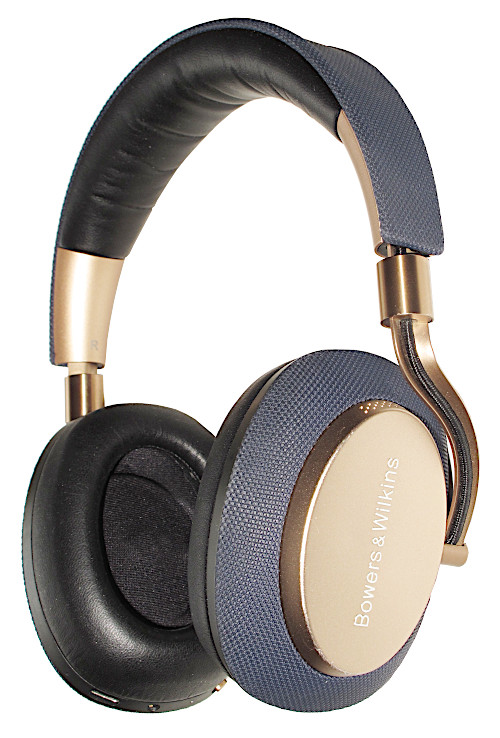PX
back to Bowers & Wilkins
back to measurements
home
published: April-22-2023
NO SMOOTHING is applied to the shown plots. Most measurement sites have some smoothing applied which ‘irons flat’ sharp peaks and ‘wiggles’. I do not use smoothing because some info about sound quality is lost when plots are smoothed.
Aside from a small correction of the microphone itself also some correction in the lowest frequencies is applied to the plots to compensate for the perceived loss of bass when using headphones. This is described HERE in more detail.
A ‘horizontal‘ frequency response curve on the shown frequency response plots on this website thus indicates a perceived ‘flat’ tonal signature.
ALL measurements are made with a good SEAL on a flatbed measurement rig.
The shape of your head, bone structure, pad size, pad ‘softness, (compliance), hair or no hair and or wearing glasses may (drastically) change the frequency response of some headphones, so… your personal experience may differ substantially from these plots.
Frequency response (tonal balance) is the most sound-determining aspect of headphones. A horizontal line shows audible neutral response in the plots on this website. Deviations in different severity at different frequency bands have an effect on the sound character.
The bigger the deviation the stronger the effect.
Below an aid to help determining the sound character of headphones with relation to the frequency response.
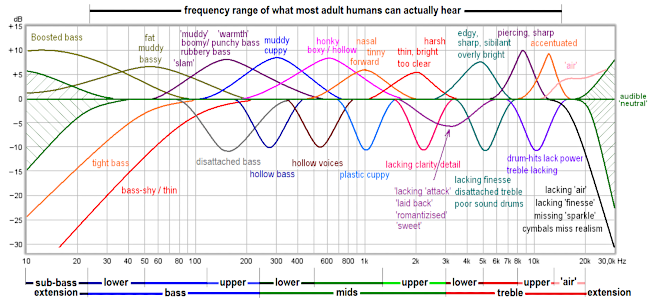
Bowers & Wilkins PX
The Bowers & Wilkins PX is B&W’s first closed over-ear wireless Noise Cancelling headphone.
Bowers and Wilkins is a luxury brand and primarily known for their loudspeakers.
The PX was launched end of 2017 and discontinued in 2020. At launch it was around € 400.- and dropped to around € 250.- by the time the successor came out.
It was available in grey-black and -blue-gold finish.
The headphone can be charged via a supplied USB-C cable plugging into a connector on the bottom of the right ear-cup. Fully charged the Lithium battery is said to work for up to 22 hours using Bluetooth + Noise Cancelling and about 6 hours more without NC. Wired the battery should last 33 hours (NC) up to 50 hours (without NC).
Alas when the battery is depleted the wired option also will not work.
When using bluetooth the usage of an accompanying app is obligatory. It allows 3 N.C. modes to be selected which can be tuned. Also the ‘on head sensor’ sensitivity can be adjusted and one can check for updates. Battery level is also shown. No tone control/EQ options or other nifty DSP functionality.
On 2 different (Android) phones the pairing went quite different. One required a few attempts to make a connection. What is a bit weird is that the app requires access to location and won’t proceed with the installation unless one allows this. No idea why ? Perhaps to check if within the E.U. is the only reason I could think off.
The PX will not be allowed to make contact with phones that do not have the app and the app did not ‘register’ the headphone.
The PX can be used with a wireless Bluetooth connection (Bluetooth 4.1), as well as directly to a USB output via the supplied (1.2m) USB-C cable and using the supplied (1.2m) 3.5mm-3.5mm TRS cable.
In BT mode it can use aptx-HD, AAC and the common SBC codecs. Aptx-HD allows for the best possible sound quality. Supported BT profiles: A2DP v1.3, AVRCP v1.6, HFP v1.6, HSP v1.2, GAP, SDAP and DIP.
There is a small LED next to the 3.5mm TRS jack which uses different colors for different functions and may or may not be blinking in specific orders.
Also there are volume up and down buttons and a start-pause button. That button can also be used to skip forward (press 2 times) or skip back (press 3 times).
Another feature is (when supported) auto-pause and auto-start when the headphone is taken off the head. Also an auto-power off and power-save function is in there.
The headband is cloth covered on top and leather covered on the bottom side and is a bit narrow with very thin padding so the part that is resting on the head is not very comfortable.
The headband can extend 35mm and has some ‘clicks’ so stays put once adjusted to the desired position.
Clamping force is a bit high (4N) but because of this it can create a decent seal (which is really very important for this headphone). Its weight of 343 gram is on the high side and caused by the higher quality metal used. The headband being rather small means that with longer listening time the weight can become uncomfortable.
The cups can swivel about 300°. The tilt is limited but big enough to get a good seal on most head sizes. In one direction the pads can lie flat on a table, in the other direction (speakers facing upwards) the angle is limited.
The real soft leather pads are exchangeable (held in place using magnets) and feel quite soft to the touch and has memory foam inside. While the pads appear to be quite thick they can only be compressed a few mm. Inside the pads there is a plastic ‘wall’ preventing the pads to be compressed more than a few mm.
Fortunately the pads are available but cost € 53.- a pair so not really cheap.
Internal height is just 58mm, width is 37mm, depth is 19mm.
It is a closed headphone and has already good isolation from outside noises. The Noise Cancelling can remove about 20dB more lower frequency noises and does not add an audible hiss when engaged.
It is recommended to always use NC. Via the app (which has to be installed in order for the headphone to work) one can set 3 different NC modes that allow to hear anything from nothing around you to being aware of the space around you or only react to voices near you. (not tested, only max attenuation)
With a very high sensitivity of 125dB/V and an unusually high impedance (910Ω measured) the PX can be used wired directly from a phone and reach high enough levels for listening at quite loud levels even from E.U. phones. E.U. phones are often limited to 0.5V max. where other regions can be 1V.
specifications:
Type: Over ear (circum-aural), closed, Noise Cancelling, wireless (Bluetooth)
Usage: Home, portable
Driver type: dynamic
Pads: replaceable, real leather
Collapsible: No, but can fold flat.
Headphone cup connector: 3.5mm TRS non-locking
Cable entry: single sided (right side).
Cable: 1.2m straight in a straight gold-plated 3.5mm TRS jack.
Inner Pad dimensions: height = 58mm, width = 37mm, depth = 19mm
Driver size: 40mm
Max. voltage: 0.7Vrms (2Vpp)
Impedance: 910Ω (measured)
Sensitivity: 125dB @ 1V
Weight: 343 g. (without cable)
Clamping force: medium/high (4N)
Bluetooth version: V4.1
Bluetooth codecs: aptx-HD, AAC, SBC
Bluetooth profiles: A2DP v1.3, AVRCP v1.6, HFP v1.6, HSP v1.2, GAP, SDAP, DIP
Charging time: 2 hours
Playing time: max. 22-50 hours
Accessories: 1.2m cable for audio, 1.2m USB-C cable, airplane adapter, carrying bag.
Subjective sound description:
With Noise Cancelling (abbreviated to N.C. further on) the sound changes a bit and is much less seal dependent. In fact I would not recommend to use this headphone without N.C. when one is wearing (reading)glasses or has hair between the pads and head.
Without noise cancelling: the amount of bass is VERY seal dependent. With good seal the sound is warm and is lacking a bit in clarity (too laid-back). The treble is not very refined, no details nor of high quality and also subdued. No sparkling treble at all but rather or low level ‘sshhh’ sound.
With noise cancelling: the bass is less present and a bit ‘honky’. Upper mids/clarity is lacking and treble is very soft and lacks details/presence. EQ’ing the treble a bit is not a good idea. You will hear more treble but because the treble quality is rather poor this becomes more evident.
Better to have the amount of treble a bit too low so the quality matters less. No sparkling treble at all but rather or low level ‘sshhh’ sound.
People looking for good quality treble and not colored sound should look elsewhere. Not very hifi but suited for background listening without fatigue.
Measurements:
Note: all measurements are done using the 3.5mm cable so not using BT.
Note: the N.C. on measurements are done in ‘airplane’ setting in the obligatory app in ‘max. setting’.
Below the frequency response of the PX with N.C. off. (Left, Right) 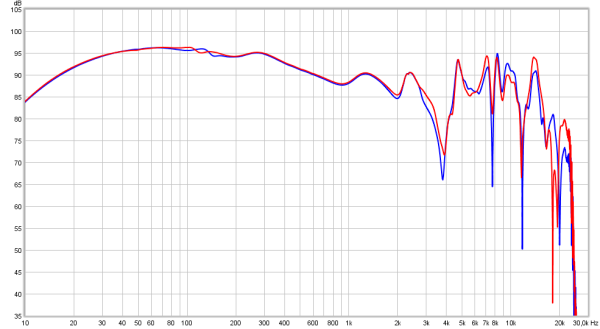 The channel matching is excellent. Bass is elevated and very well extended. The dropping response between 300Hz and 3kHz gives the headphone a very ‘warm’ tonal balance. The wiggles above 1kHz and steep dip around 4kHz make the upper mids sound quite recessed (laid-back) and thus lacks clarity and brilliance in voices. Unfortunately above 4kHz the treble response is far from flat, has lots of dips and peaks and the average level is too low as well. This results in rather poor treble quality.
The channel matching is excellent. Bass is elevated and very well extended. The dropping response between 300Hz and 3kHz gives the headphone a very ‘warm’ tonal balance. The wiggles above 1kHz and steep dip around 4kHz make the upper mids sound quite recessed (laid-back) and thus lacks clarity and brilliance in voices. Unfortunately above 4kHz the treble response is far from flat, has lots of dips and peaks and the average level is too low as well. This results in rather poor treble quality.
Below the frequency response of the PX with N.C. on. (Left, Right) 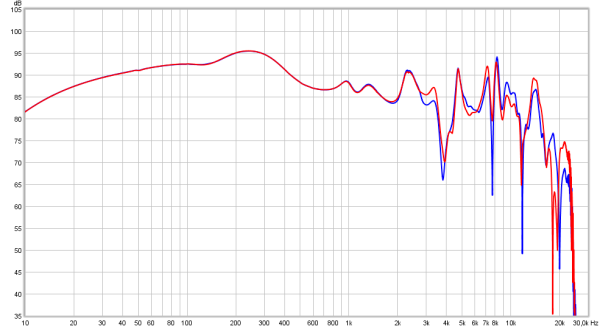 The channel matching is excellent. Bass is elevated and very well extended. There is a weird ‘bump’ around 250Hz which makes the bass a bit muddy and lacking in quality. Overall the bass levels are now at a better level compared to the mids and treble so the PX sounds a bit more ‘neutral’ and clarity is slightly better but still ‘overruled’ by the muddy high bass/lower mids. Treble quality is not good and lacks detail and sparkle and is not refined.
The channel matching is excellent. Bass is elevated and very well extended. There is a weird ‘bump’ around 250Hz which makes the bass a bit muddy and lacking in quality. Overall the bass levels are now at a better level compared to the mids and treble so the PX sounds a bit more ‘neutral’ and clarity is slightly better but still ‘overruled’ by the muddy high bass/lower mids. Treble quality is not good and lacks detail and sparkle and is not refined.
Below the difference between the 2 possible modes: N.C. off and N.C. on.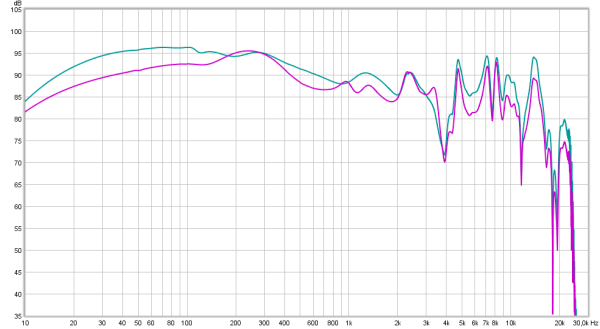 Note that aside from a tonal balance difference the overall level also differs.
Note that aside from a tonal balance difference the overall level also differs.
When looking at the frequency plot above (and the phase plot below) that there is a steep drop in frequency response around 24kHz.
This is because the incoming audio (analog TRS cable) signal is converted to digital with a 48kHz sampling rate. As this is not ‘properly’ done by filtering the bandwidth before it is converted there is aliasing visible. The plot below runs from 20kHz to 30kHz (Left, Right) and shows the aliasing around half the sampling frequency (so 24kHz for 48kHz sampling frequency). As this is above the audible range it is not audible. Clearly it makes no sense to play HiRes audio into this headphone.
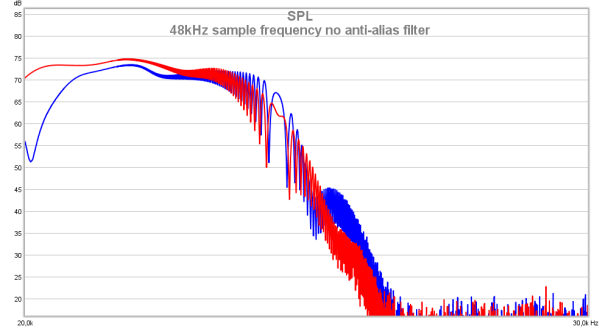
Phase response
Below the phase response of the PX with N.C. off. (Left, Right) 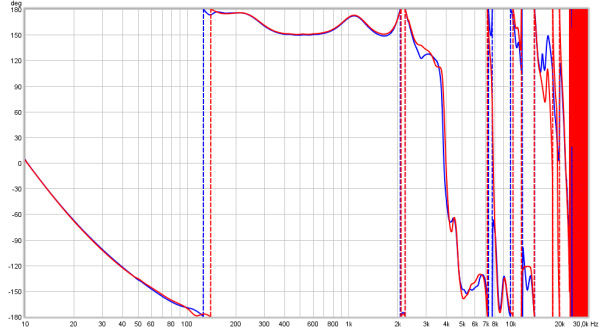 Note: the phase is inverse (180 degrees) from the majority of headphones. This is sometimes seen with headphones that have electronics inside.
Note: the phase is inverse (180 degrees) from the majority of headphones. This is sometimes seen with headphones that have electronics inside.
Slow phase shifts are not very audible. Sharp changes in a narrow frequency bands may well be audible. Around 4kHz there is a steep and substantial phase shift, as well as a bit higher up in frequency. This is an indicator for poor treble quality.
Below the phase response of the PX with N.C. on. (Left, Right) 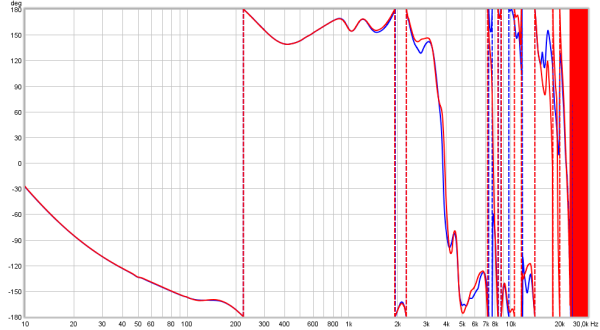 The behavior is very similar (just slightly different) compared to noise cancelling off.
The behavior is very similar (just slightly different) compared to noise cancelling off.
comparisons to other wireless headphones
Below the B&W PX versus some other wireless (Bluetooth) headphones. Some have N.C. When a headphone does have N.C. that mode is shown in the comparison below.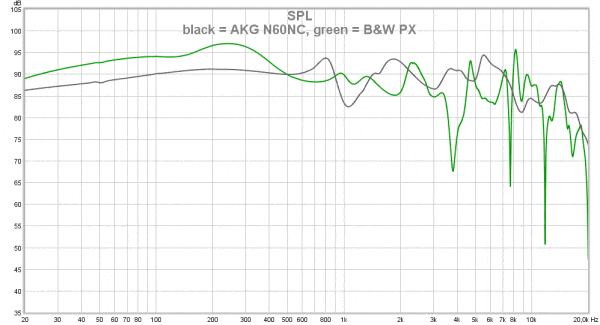
output resistance / damping-factor
As this headphone has an input resistance of 910Ω it does not present a significant load to the incoming signal and is purely resistive as well so not frequency dependent.
For that reason there is virtually no damping nor voltage division so no graph either as all traces simply overlay.
There was, however, something odd going on. When driven from 0.1, 10 and 32Ω the headphone functioned normally but from a 120Ω source the output dropped substantially. My assumption is that the PX senses whether or no a device is connected to the input and above a certain resistance decides to switch over to the internal BT receiver.
So chances are that when the PX is connected via the 3.5mm cable to a receiver with a high output resistance headphone out there will be no, or very soft, sound coming from the headphone.
seal and noise cancelling
Seal is an issue with closed-back headphones. This headphone is no exception and is even highly dependent on a good seal. Slightly lifting the pads, hair or glasses with arms not resting against the skin directly affects bass extension.
Note that due to the way noise cancelling works this effect can be greatly reduced. So with noise cancelling on the seal loss is compensated (up to a certain point to which it can) by increasing the output of the driver.
The way this works is by using a feedback microphone situated directly above the driver. This small microphone can be seen when looking at the driver. It is the small hump in the center.
That microphone picks up the signal inside the cup and compares that (real time) to the incoming signal. When, due to seal loss, the amount of bass drops (see plot below) the internal amplifier puts out more signal to compensate what is lost. This it can only do up to a certain amount. When seal loss becomes too big the amplifier cannot compensate more and there will be a roll-off again from that point. Frequencies above 2kHz are not ‘corrected’ using this method. Above 1kHz the effectiveness of the correction starts to become less already.
Below a measurement of the headphone with seal loss (in different degrees) with N.C. off.
Perfect seal, seal broken by thick armed glasses resting against the skin. Seal broken by thick armed glasses not resting against the skin.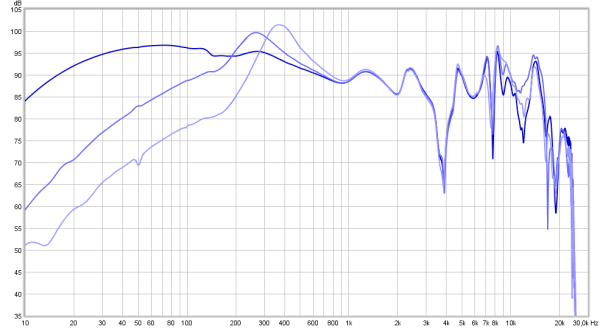
Only with a perfect seal there is elevated bass. With just a very slight seal breakage will result in a severe loss of bass and weird ‘honky’ mids.
Below a measurement of the headphone with seal loss (in different degrees) with N.C. on.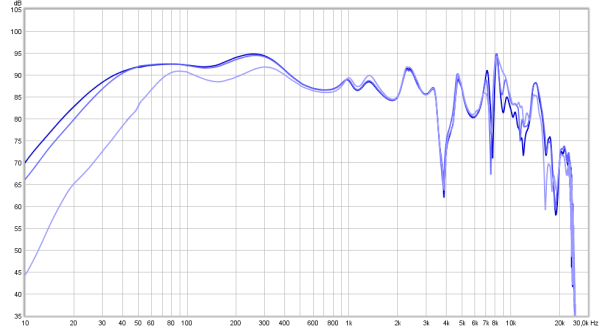 It is clear that with some slight loss of seal the bass response is not affected. Even a bit more loss of seal results in some loss of the lowest notes but bass is still there.
It is clear that with some slight loss of seal the bass response is not affected. Even a bit more loss of seal results in some loss of the lowest notes but bass is still there.
This is the biggest reason why this headphone should always be used with the noise cancelling mode on (white indicator LED).
Below the distortion measurements of the PX with N.C. off. (left channel) The plot above shows the level differences between the signal (upper trace) and the harmonics.
The plot above shows the level differences between the signal (upper trace) and the harmonics.
Most people prefer to see percentages instead of level differences so below the exact same plot except ‘normalized’ to the actual signal and level differences given in percentages.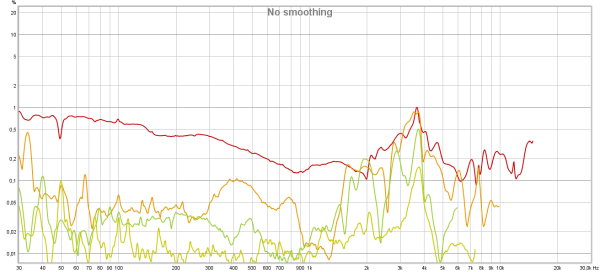 Distortion levels in the lowest frequencies are mostly 2nd harmonic up to a few kHz around 3.8kHz there seem to be some issues as higher harmonics peak right in a part of the frequency response the ears are most sensitive and reaches over 1% at 90dB.
Distortion levels in the lowest frequencies are mostly 2nd harmonic up to a few kHz around 3.8kHz there seem to be some issues as higher harmonics peak right in a part of the frequency response the ears are most sensitive and reaches over 1% at 90dB.
One should realize that the peak in the percentage plot is higher than the actual signal because of the dip in the frequency response at this frequency. Best to look at both measurements to gauge distortion levels and not stare blind on the percentage plot (near 3.8kHz)
The driver performs well at low frequencies.
Below the distortion measurements of the PX with N.C. on. (left channel) The plot above shows the level differences between the signal (upper trace) and the harmonics.
The plot above shows the level differences between the signal (upper trace) and the harmonics.
Most people prefer to see percentages instead of level differences so below the exact same plot except ‘normalized’ to the actual signal and level differences given in percentages.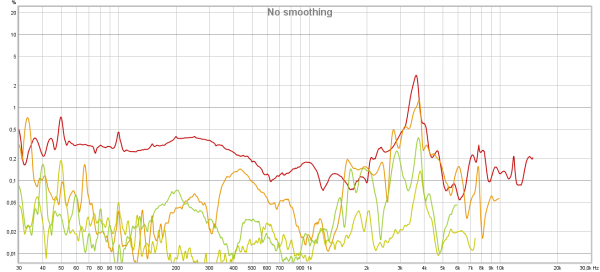 Distortion levels in the lowest frequencies dropped due to the acoustic feedback mechanism that is noise cancelling. However, around 4kHz, the problem area of this headphone, the distortion increases a bit. As mids are more aligned in level this is even compounded a bit more.
Distortion levels in the lowest frequencies dropped due to the acoustic feedback mechanism that is noise cancelling. However, around 4kHz, the problem area of this headphone, the distortion increases a bit. As mids are more aligned in level this is even compounded a bit more.
The actual 2nd harmonic distortion above 500Hz may well be lower than 0.2% . A shortcoming of my measurement rig.
Below the CSD (waterfall) plot of the PX with N.C. off. (Left and Right are overlaid) There are quite some resonances visible. At 4.8kHz there is a longer lasting resonance.
There are quite some resonances visible. At 4.8kHz there is a longer lasting resonance.
This is also shown in the frequency plots so clearly something the driver is not reproducing that well.
Below the CSD (waterfall) plot of the PX with N.C. on. (Left and Right are overlaid)
The interesting part here is the reduction below 2kHz caused by the acoustic feedback (N.C.)
Above 2kHz noting changed and shows where the N.C. stops being active.
Below the Group Delay plot for the PX with N.C. off. (Left, Right)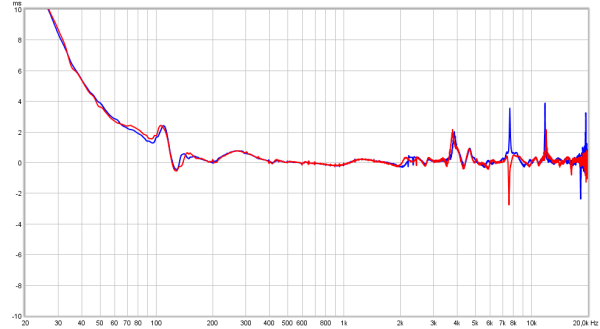 and the Group Delay with N.C. on (Left, Right)
and the Group Delay with N.C. on (Left, Right) The N.C. actively reduces the pad bounce at around 120Hz. Near 1kHz the N.C. circuit starts to loose effectiveness resulting the small ‘wiggle’ above 2kHz the N.C. does nothing any more. There are similar resonances showing in both use cases.
The N.C. actively reduces the pad bounce at around 120Hz. Near 1kHz the N.C. circuit starts to loose effectiveness resulting the small ‘wiggle’ above 2kHz the N.C. does nothing any more. There are similar resonances showing in both use cases.
Step response
Below the step response plot which, when the sound is balanced and well extended should show a fast rise to around 0dB, (indicating fast driver response) and then should be slightly sloping downwards indicating bass extension. (Left, Right N.C. off)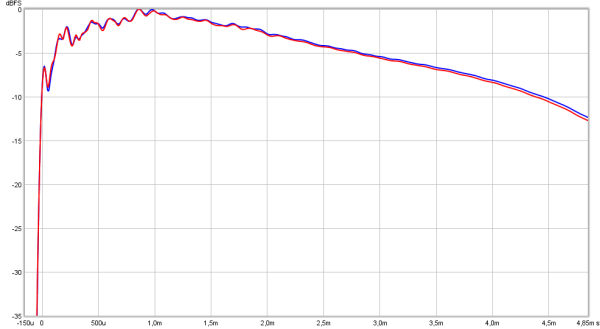
Bass extension is very good (with a good seal) as indicated by the horizontal part barely sloping.
The initial rise is reaching only -7dB and then slowly rises over the following millisecond.
This shows the ‘dark’ sound signature and lack of clarity/brilliance.
Below the step response with N.C. on.
conclusion
The Bowers & Wilkins PX is a premium looking and feeling wireless noise cancelling headphone.
It was (no longer available) fairly expensive but has real leather and metal parts giving it a quality and luxury feel.
The PX requires an app in order to use it with Bluetooth. That app also requires to know the location which seems to be unnecessary to be able to use it.Once connected you have access to updates and 3 different noise cancelling modes.
It can also be used via USB-C and 3.5mm TRS jack analog in.
The sound quality is not sufficient for audiophiles. The bass is not tight, the sound too warm, it lacks clarity and presence and the treble is subdued and of poor quality.
It is obvious most of the price went into premium materials and looks, alas not in sound quality.
With EQ the low treble and upper mids quality becomes even more evident so best not to use it with EQ.
It is highly recommended to use it with noise cancelling. Without it the seal becomes very important. A little loss of seal results in loss of bass and honky sound. With noise cancelling it is more forgiving.
Another downside is that it always needs a battery to work. When the battery is depleted it cannot be used wired either. With some BT headphones at least you can still use it, just not wireless. Not so with the PX.
The PX is quite heavy and the contact area and headband padding as well as room for the ears is an issue. Not very comfortable for longer listening levels.
Is it completely worthless ? No, those that like the looks and feel is premium. The noise cancelling works quite well and there is good attenuation even when powered off. The ‘talk-through’ functionality is handy.
When one likes a warm and relaxed sound and does not want splashy or detailed sound but just some music playing and isolation from outside noises this might fit the bill.
It is not worth € 400 nor € 250 for what it sold for in the end. The value (sound quality wise) is somewhere between € 50.- and € 100.-

